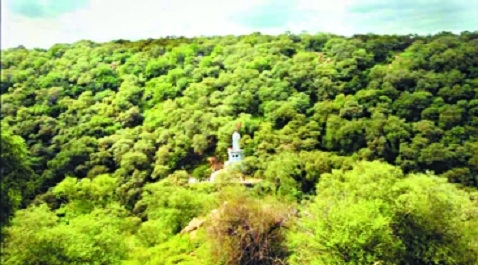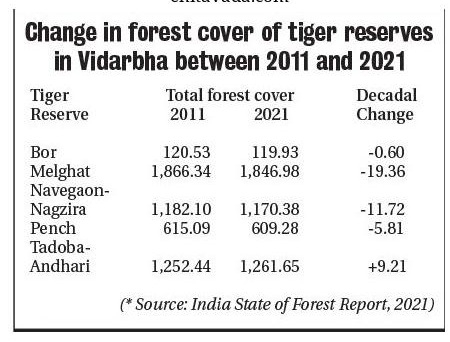Decadal decline in forest cover in 4 out of 5 tiger reserves in Vidarbha
| Date :14-Jan-2022 |

By Kartik Lokhande :
What was long suspected has come out on record. The Forest Survey of India (FSI), on Thursday, released its biennial ‘India State of Forest Report’ which revealed that four out of five tiger reserves in Vidarbha region registered decline in forest cover in the decade between 2011 and 2021. The report brings out change in forest cover of tiger reserves by comparing the data of assessments in 2011 and 2021. Nationally, the report brings out that there has been decadal decline in forest cover across 52 tiger reserves in the country and also in the only Lion Conservation Area of Gir in Gujarat. The overall decadal decline in forest cover across 52 tiger reserves in the country has been 22.62 sq km. The report has assessed the area of very dense forest (VDF) with canopy density above 70 per cent, moderately dense forest (MDF) with canopy density between 40 per cent and 70 per cent, and open forest (OF) with canopy density between 10 per cent and 40 per cent.

The report has also recorded scrub, which is not part of the forest cover. Vidarbha region’s five tiger reserves namely Bor, Melghat, Navegaon-Nagzira, Pench, and Tadoba-Andhari have featured in the ‘India State of Forest Report-2021’. The analysis of decadal change has revealed that forest cover in four out of these tiger reserves, Tadoba-Andhari being exception, registered decline. In case of Tadoba-Andhari Tiger Reserve (TATR) in Chandrapur district, which has of late earned the dubious distinction as the hotbed of man-animal conflict, the forest cover has actually increased marginally by 9.21 sq km. It has increased from 1,252.44 sq km in 2011 to 1,261.65 sq km in 2021. However, it has lost 5.31 sq km of VDF. It has recorded gains of 12.75 sq km in MDF, and 1.77 sq km in OF. Besides, it has registered decline of 0.28 sq km in the category of scrub. The decadal decline has been the highest in case of Melghat Tiger Reserve in Amravati district. The forest cover has declined by 19.36 sq km -- from 1,866.34 sq km in 2011 to 1,846.98 sq km in 2021. Here, too, the maximum decline is in VDF. Melghat Tiger Reserve has lost 25.08 sq km of very dense forest in the decade 2011-2021. Further it has lost 5.63 sq km of OF. But, it has recorded gain of 11.35 sq km in MDF category. Even the scrub has declined by 0.02 sq km. Melghat is followed by Navegaon-Nagzira Tiger Reserve (NNTR), which has registered decline in forest cover by 11.72 sq km -- from 1,182.10 sq km in 2011 to 1,170.38 sq km in 2021. Creditably, its VDF has increased by 2.64 sq km. But, NNTR has recorded decline of 3.50 sq km of MDF and 10.86 sq km of OF. In scrub category, too, it has made gains of 0.44 sq km. In the decade from 2011 to 2021, Pench Tiger Reserve (PTR) has seen decline in forest cover by 5.81 sq km -- from 615.09 sq km to 609.28 sq km. The PTR has recorded decadal decline of 0.28 sq km in case of VDF, and 6.75 sq km in OF.
At the same time, it has registered gain of 1.22 sq km in moderately dense forest. Bor, which is the smallest tiger reserve and relatively the youngest in Vidarbha, also has registered decadal decline, albeit marginal, of 0.60 sq km. Its forest cover has declined from 120.53 sq km in 2011 to 119.93 sq km in 2021. Though it gained 2.28 sq km in OF category, it has recorded decline of 0.02 sq km in VDF and 2.86 sq km in MDF categories. Highlighting the importance of forest cover in tiger reserves, the report states, “The distribution of Tigers and their density in the forests vary because of several ecological factors such as forest cover, terrain and natural prey availability and also because of anthropogenic factors like presence of undisturbed habitat and management interventions.” The extent of forest cover in Tiger Reserves is an important indicator of the health of the forest ecosystem, and is an important determinant of the presence or absence of prey populations.